语言学论述题答案
- 格式:doc
- 大小:26.50 KB
- 文档页数:3
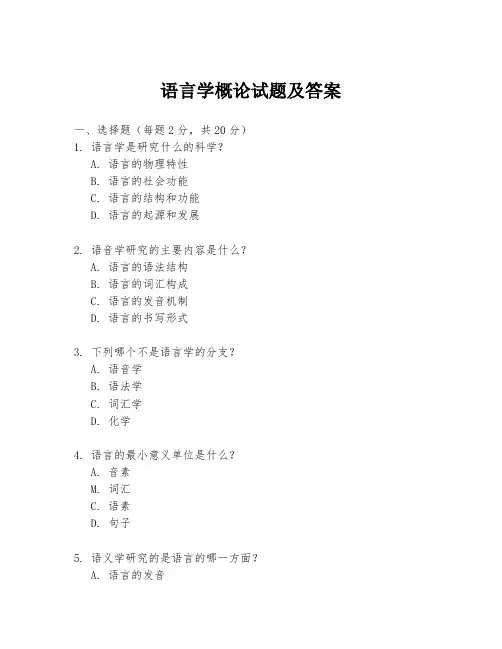
语言学概论试题及答案一、选择题(每题2分,共20分)1. 语言学是研究什么的科学?A. 语言的物理特性B. 语言的社会功能C. 语言的结构和功能D. 语言的起源和发展2. 语音学研究的主要内容是什么?A. 语言的语法结构B. 语言的词汇构成C. 语言的发音机制D. 语言的书写形式3. 下列哪个不是语言学的分支?A. 语音学B. 语法学C. 词汇学D. 化学4. 语言的最小意义单位是什么?A. 音素M. 词汇C. 语素D. 句子5. 语义学研究的是语言的哪一方面?A. 语言的发音B. 语言的意义C. 语言的书写D. 语言的语法6. 语言的词汇量是如何增长的?A. 通过新词的创造B. 通过旧词的淘汰C. 通过语言的混合D. 通过语言的简化7. 什么是语言的方言?A. 一种语言的书面形式B. 一种语言的口头形式C. 一种语言的地区变体D. 一种语言的官方标准8. 语言的同化现象是指什么?A. 语言的统一B. 语言的分化C. 语言的借用D. 语言的变异9. 语言的转换是指什么?A. 语言的翻译B. 语言的转写C. 语言的转述D. 语言的转换10. 什么是语言的语境?A. 语言的使用环境B. 语言的书写环境C. 语言的发音环境D. 语言的语法环境二、填空题(每题2分,共10分)11. 语言学的两大分支是________和________。
12. 语言的音位系统是由________构成的。
13. 语言的语法规则包括词法规则和________。
14. 语言的词汇化是指________转化为词汇的过程。
15. 语言的语用学研究的是语言在________中的使用。
三、简答题(每题10分,共20分)16. 简述语言的交际功能。
17. 简述语言的规范性与变异性。
四、论述题(每题15分,共30分)18. 论述语言与文化的关系。
19. 论述语言的演变过程及其影响因素。
五、案例分析题(每题20分,共20分)20. 请分析一种方言的形成过程,并讨论其对标准语的影响。
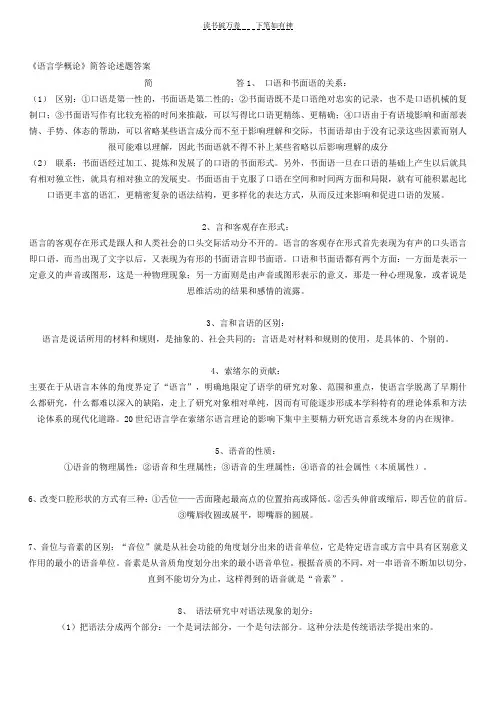
《语言学概论》简答论述题答案简答1、口语和书面语的关系:(1)区别:①口语是第一性的,书面语是第二性的;②书面语既不是口语绝对忠实的记录,也不是口语机械的复制口;③书面语写作有比较充裕的时间来推敲,可以写得比口语更精练、更精确;④口语由于有语境影响和面部表情、手势、体态的帮助,可以省略某些语言成分而不至于影响理解和交际,书面语却由于没有记录这些因素而别人很可能难以理解,因此书面语就不得不补上某些省略以后影响理解的成分(2)联系:书面语经过加工、提炼和发展了的口语的书面形式。
另外,书面语一旦在口语的基础上产生以后就具有相对独立性,就具有相对独立的发展史。
书面语由于克服了口语在空间和时间两方面和局限,就有可能积累起比口语更丰富的语汇,更精密复杂的语法结构,更多样化的表达方式,从而反过来影响和促进口语的发展。
2、言和客观存在形式:语言的客观存在形式是跟人和人类社会的口头交际活动分不开的。
语言的客观存在形式首先表现为有声的口头语言即口语,而当出现了文字以后,又表现为有形的书面语言即书面语。
口语和书面语都有两个方面:一方面是表示一定意义的声音或图形,这是一种物理现象;另一方面则是由声音或图形表示的意义,那是一种心理现象,或者说是思维活动的结果和感情的流露。
3、言和言语的区别:语言是说话所用的材料和规则,是抽象的、社会共同的;言语是对材料和规则的使用,是具体的、个别的。
4、索绪尔的贡献:主要在于从语言本体的角度界定了“语言”,明确地限定了语学的研究对象、范围和重点,使语言学脱离了早期什么都研究,什么都难以深入的缺陷,走上了研究对象相对单纯,因而有可能逐步形成本学科特有的理论体系和方法论体系的现代化道路。
20世纪语言学在索绪尔语言理论的影响下集中主要精力研究语言系统本身的内在规律。
5、语音的性质:①语音的物理属性;②语音和生理属性;③语音的生理属性;④语音的社会属性(本质属性)。
6、改变口腔形状的方式有三种:①舌位——舌面隆起最高点的位置抬高或降低。
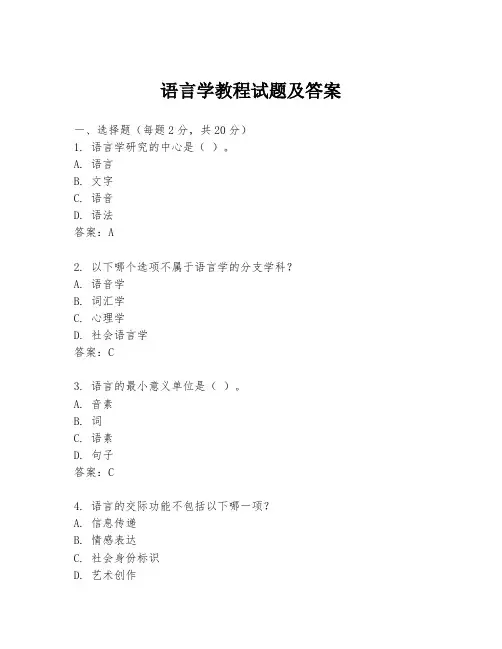
语言学教程试题及答案一、选择题(每题2分,共20分)1. 语言学研究的中心是()。
A. 语言B. 文字C. 语音D. 语法答案:A2. 以下哪个选项不属于语言学的分支学科?A. 语音学B. 词汇学C. 心理学D. 社会语言学答案:C3. 语言的最小意义单位是()。
A. 音素B. 词C. 语素D. 句子答案:C4. 语言的交际功能不包括以下哪一项?A. 信息传递B. 情感表达C. 社会身份标识D. 艺术创作5. 以下哪个术语不是索绪尔语言学理论中的概念?A. 语言符号B. 语言系统C. 语言行为D. 语言结构答案:C6. 语言的演变过程不包括以下哪一项?A. 语音变化B. 词汇变化C. 语法变化D. 文化变化答案:D7. 以下哪个选项不是语言的交际方式?A. 口头交流B. 书面交流C. 非言语交流D. 内心独白答案:D8. 语言的规范性主要体现在()。
A. 语法规则B. 词汇使用C. 语音系统D. 所有以上选项答案:D9. 以下哪个选项不是语言的变异现象?B. 社会方言C. 语言混合D. 语言的统一答案:D10. 语言的生成性是指()。
A. 语言的创造性B. 语言的稳定性C. 语言的规范性D. 语言的交际功能答案:A二、填空题(每题2分,共20分)1. 语言学是一门研究人类语言的科学,其研究对象包括语言的结构、功能、起源和发展等。
2. 语言的音位学研究的是语言的_________系统。
答案:语音3. 语言的词汇学研究的是语言的_________单位。
答案:词4. 语言的句法学研究的是语言的_________结构。
答案:句子5. 语言的语用学研究的是语言在_________中的使用。
答案:交际6. 语言的语料库语言学研究的是语言的_________数据。
答案:实际7. 语言的语义学研究的是语言的_________关系。
答案:意义8. 语言的语篇分析研究的是语言的_________结构。
答案:连贯9. 语言的对比语言学研究的是不同语言之间的_________关系。
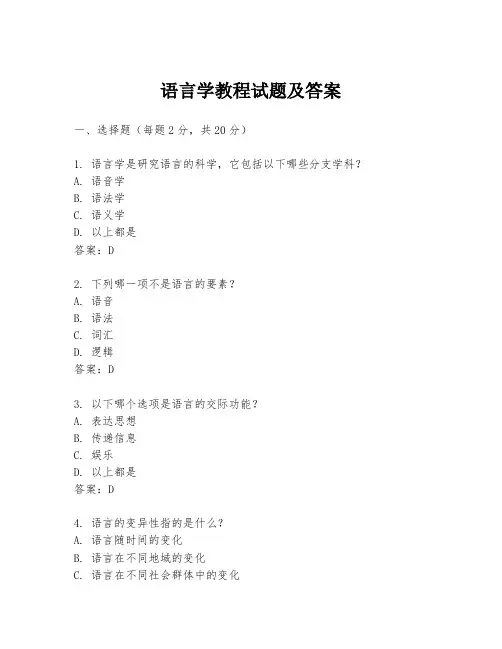
语言学教程试题及答案一、选择题(每题2分,共20分)1. 语言学是研究语言的科学,它包括以下哪些分支学科?A. 语音学B. 语法学C. 语义学D. 以上都是答案:D2. 下列哪一项不是语言的要素?A. 语音B. 语法C. 词汇D. 逻辑答案:D3. 以下哪个选项是语言的交际功能?A. 表达思想B. 传递信息C. 娱乐D. 以上都是答案:D4. 语言的变异性指的是什么?A. 语言随时间的变化B. 语言在不同地域的变化C. 语言在不同社会群体中的变化D. 以上都是答案:D5. 以下哪一项不是语言的属性?A. 任意性B. 创造性C. 规律性D. 可变性答案:D6. 语言学中“音位”指的是什么?A. 语言中最小的音义结合单位B. 语言中最小的意义单位C. 语言中最小的语音单位D. 语言中最小的语法单位答案:C7. 语言的“语法”指的是什么?A. 语言的发音规则B. 语言的词汇规则C. 语言的句法规则D. 语言的语义规则答案:C8. 以下哪一项是语言的语义学研究的内容?A. 音位的分类B. 词义的演变C. 句法结构的规则D. 语言的交际功能答案:B9. 语言的“方言”是指什么?A. 一种语言的不同变体B. 一种语言的书面形式C. 一种语言的口头形式D. 一种语言的文学形式答案:A10. 以下哪一项不是语言的语用学研究的内容?A. 语境对语言使用的影响B. 语言的交际功能C. 语言的词汇规则D. 语言的交际策略答案:C二、填空题(每题2分,共20分)1. 语言学的四大分支学科包括语音学、语法学、语义学和______。
答案:语用学2. 语言的任意性是指语言的______和意义之间没有必然的联系。
答案:形式3. 语言的创造性表现在人们可以创造新的______来表达新的概念。
答案:词汇4. 语言的规律性是指语言具有______的规则。
答案:系统性5. 语言的变异性包括语言随时间的______、地域的______以及社会群体的______。
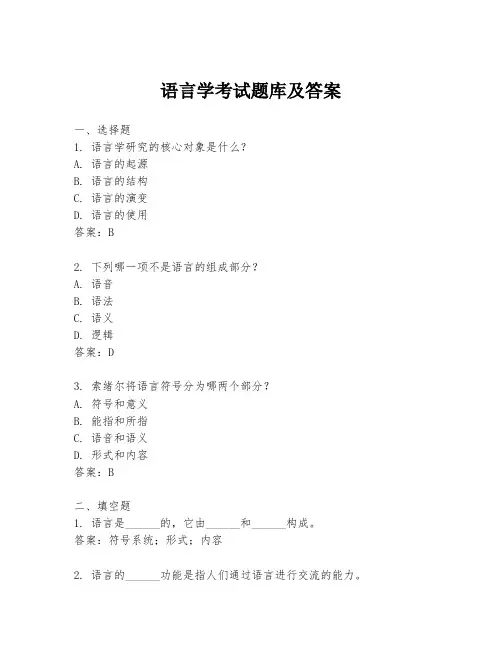
语言学考试题库及答案一、选择题1. 语言学研究的核心对象是什么?A. 语言的起源B. 语言的结构C. 语言的演变D. 语言的使用答案:B2. 下列哪一项不是语言的组成部分?A. 语音B. 语法C. 语义D. 逻辑答案:D3. 索绪尔将语言符号分为哪两个部分?A. 符号和意义B. 能指和所指C. 语音和语义D. 形式和内容答案:B二、填空题1. 语言是______的,它由______和______构成。
答案:符号系统;形式;内容2. 语言的______功能是指人们通过语言进行交流的能力。
答案:交流3. 语言的______功能是指语言能够表达思想和情感的能力。
答案:表达三、简答题1. 简述语言和言语的区别。
答案:语言是指一种抽象的符号系统,它包括语音、语法、语义等规则和结构;言语则是指个人使用语言进行交流的具体行为。
2. 描述索绪尔的“能指”和“所指”概念。
答案:索绪尔认为语言符号由“能指”和“所指”两部分组成。
“能指”指的是语言符号的声音形式,而“所指”指的是符号所代表的概念或意义。
四、论述题1. 论述语言的任意性原则及其对语言学习和教学的影响。
答案:语言的任意性原则指的是语言符号的声音形式和它所代表的概念之间没有必然的联系。
这一原则对语言学习和教学有着深远的影响,因为它意味着学习者需要记忆每个符号的声音和意义之间的联系,而不能依赖于逻辑或直观的关联。
这对语言教学提出了挑战,要求教师设计有效的教学方法来帮助学生记忆和理解这些任意的联系。
2. 分析语言的交际功能及其在现代社会中的重要性。
答案:语言的交际功能是指语言作为交流工具,使人们能够传递信息、表达情感和进行社会互动。
在现代社会,随着全球化和信息技术的发展,语言的交际功能变得尤为重要。
有效的沟通能够促进国际合作、文化交流和商业交易,同时也有助于解决社会冲突和增进理解。
因此,掌握一门或多门语言对于个人和社会的发展至关重要。
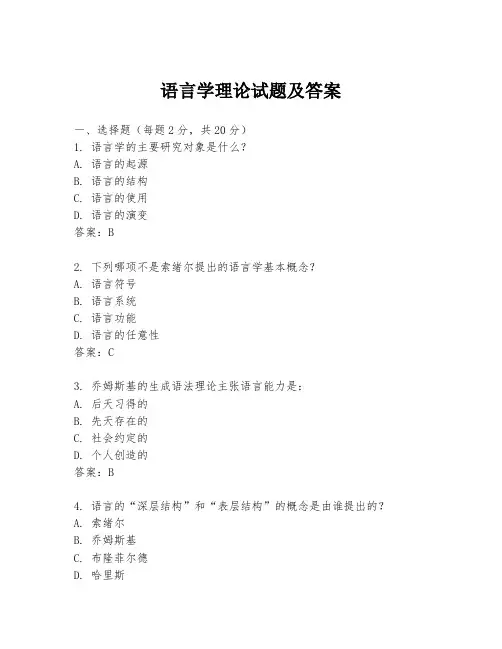
语言学理论试题及答案一、选择题(每题2分,共20分)1. 语言学的主要研究对象是什么?A. 语言的起源B. 语言的结构C. 语言的使用D. 语言的演变答案:B2. 下列哪项不是索绪尔提出的语言学基本概念?A. 语言符号B. 语言系统C. 语言功能D. 语言的任意性答案:C3. 乔姆斯基的生成语法理论主张语言能力是:A. 后天习得的B. 先天存在的C. 社会约定的D. 个人创造的答案:B4. 语言的“深层结构”和“表层结构”的概念是由谁提出的?A. 索绪尔B. 乔姆斯基C. 布隆菲尔德D. 哈里斯答案:B5. 语言的“同义异构”现象是指:A. 同一意义的不同表达方式B. 不同意义的相同表达方式C. 同一表达方式的不同意义D. 不同表达方式的相同意义答案:A6. 语言的“语境”指的是:A. 语言的内部结构B. 语言的外部环境C. 语言的使用者D. 语言的规则答案:B7. 语言的“语域”通常指的是:A. 语言的地域分布B. 语言的交际场合C. 语言的历史发展D. 语言的语法规则答案:B8. 语言的“语用学”研究的是:A. 语言的发音B. 语言的意义C. 语言的用法D. 语言的演变答案:C9. 语言的“语料库”是指:A. 语言的数据库B. 语言的规则集C. 语言的样本集D. 语言的词汇表答案:C10. 语言的“方言”是指:A. 同一语言的不同变体B. 不同语言的相似形式C. 同一语言的相同形式D. 不同语言的相同变体答案:A二、填空题(每题2分,共20分)1. 语言学的四大分支包括语音学、语法学、语义学和______。
答案:语用学2. 语言的“能指”指的是语言符号的______部分,而“所指”指的是语言符号的______部分。
答案:形式;意义3. 语言的“同音词”是指发音相同但______不同的词。
答案:意义4. 语言的“词缀”是指可以附加在词根上的______或______。
答案:前缀;后缀5. 语言的“句法”研究的是词、短语和句子的______。
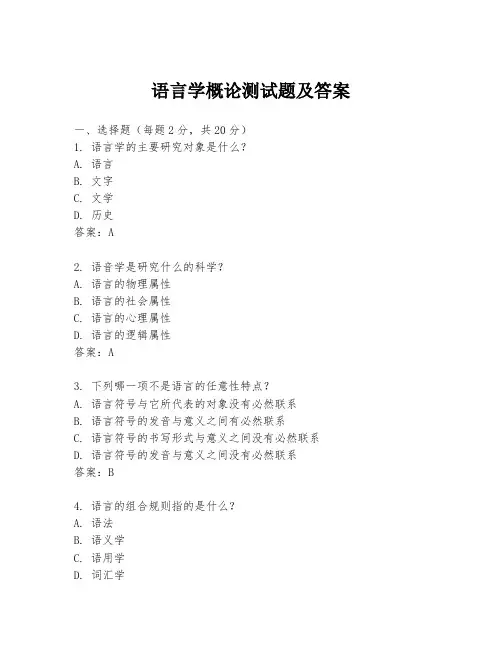
语言学概论测试题及答案一、选择题(每题2分,共20分)1. 语言学的主要研究对象是什么?A. 语言B. 文字C. 文学D. 历史答案:A2. 语音学是研究什么的科学?A. 语言的物理属性B. 语言的社会属性C. 语言的心理属性D. 语言的逻辑属性答案:A3. 下列哪一项不是语言的任意性特点?A. 语言符号与它所代表的对象没有必然联系B. 语言符号的发音与意义之间有必然联系C. 语言符号的书写形式与意义之间没有必然联系D. 语言符号的发音与意义之间没有必然联系答案:B4. 语言的组合规则指的是什么?A. 语法B. 语义学C. 语用学D. 词汇学5. 语言的演变遵循什么原则?A. 经济原则B. 复杂原则C. 简单原则D. 随意原则答案:A6. 社会语言学关注的是语言与什么的关系?A. 社会B. 心理C. 个人D. 文化答案:A7. 儿童语言习得的关键期通常被认为是在什么年龄之前?A. 3岁B. 6岁C. 12岁D. 18岁答案:C8. 语言的交际功能包括哪些?A. 信息传递B. 情感表达C. 社会互动D. 所有以上答案:D9. 语言的层级结构包括哪些?B. 词汇层C. 句法层D. 所有以上答案:D10. 转换生成语法的创始人是谁?A. 费尔迪南·德·索绪尔B. 诺姆·乔姆斯基C. 罗曼·雅各布森D. 列昂·布隆菲尔德答案:B二、填空题(每题2分,共20分)1. 语言学通常被分为两大类:______和应用语言学。
答案:理论语言学2. 语言的最小意义单位是______。
答案:语素3. 语言的最小音位单位是______。
答案:音素4. 语言的最小语法单位是______。
答案:词5. 语言的最小语义单位是______。
答案:词义6. 语言的最小语用单位是______。
答案:话语7. 语言的最小交际单位是______。
答案:句子8. 语言的最小社会单位是______。
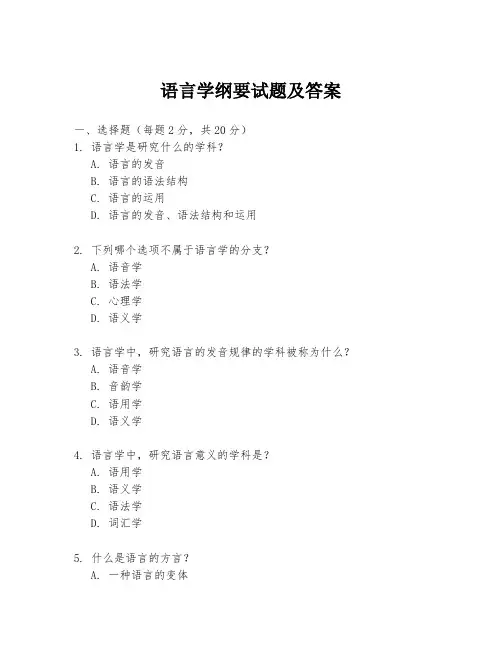
语言学纲要试题及答案一、选择题(每题2分,共20分)1. 语言学是研究什么的学科?A. 语言的发音B. 语言的语法结构C. 语言的运用D. 语言的发音、语法结构和运用2. 下列哪个选项不属于语言学的分支?A. 语音学B. 语法学C. 心理学D. 语义学3. 语言学中,研究语言的发音规律的学科被称为什么?A. 语音学B. 音韵学C. 语用学D. 语义学4. 语言学中,研究语言意义的学科是?A. 语用学B. 语义学C. 语法学D. 词汇学5. 什么是语言的方言?A. 一种语言的变体B. 一种完全不同的语言C. 一种语言的书面形式D. 一种语言的口头形式6. 语言学中,研究语言随时间变化的学科被称为什么?A. 历史语言学B. 社会语言学C. 比较语言学D. 结构语言学7. 下列哪个选项是研究语言与社会之间的关系的学科?A. 社会语言学B. 心理语言学C. 计算语言学D. 应用语言学8. 语言学中,研究语言如何被用来达到交际目的的学科是?A. 语用学B. 语义学C. 语法学D. 语音学9. 什么是语言的同源词?A. 来自不同语言的词B. 来自同一语言的词C. 来自同一词根的词D. 来自同一语言家族的词10. 语言学中,研究语言结构的学科被称为什么?A. 结构语言学B. 语音学C. 语义学D. 语用学答案:1-5 D C A A A 6-10 A A A C A二、填空题(每题2分,共10分)1. 语言学的四大分支包括语音学、语法学、语义学和______。
答案:语用学2. 语言学研究的两个主要领域是______和______。
答案:理论语言学;应用语言学3. 语言的方言是指在某一特定地区或社会群体中使用的______。
答案:语言变体4. 语言学中,研究语言随时间变化的学科是______。
答案:历史语言学5. 语言学中,研究语言与社会之间的关系的学科是______。
答案:社会语言学三、简答题(每题10分,共20分)1. 请简述语言学的主要研究内容。
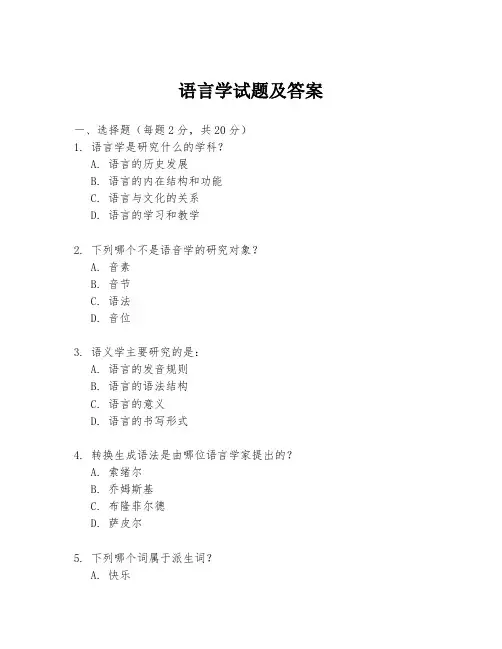
语言学试题及答案一、选择题(每题2分,共20分)1. 语言学是研究什么的学科?A. 语言的历史发展B. 语言的内在结构和功能C. 语言与文化的关系D. 语言的学习和教学2. 下列哪个不是语音学的研究对象?A. 音素B. 音节C. 语法D. 音位3. 语义学主要研究的是:A. 语言的发音规则B. 语言的语法结构C. 语言的意义D. 语言的书写形式4. 转换生成语法是由哪位语言学家提出的?A. 索绪尔B. 乔姆斯基C. 布隆菲尔德D. 萨皮尔5. 下列哪个词属于派生词?A. 快乐B. 快速C. 快乐地D. 快车6. 句法学研究的是:A. 句子的构成B. 词义的组合C. 语言的发音D. 语言的书写7. 社会语言学关注的是:A. 语言的变异与变化B. 语言与社会的关系C. 语言的起源和发展D. 语言的标准化8. 语言的功能主义理论是由下列哪位语言学家提出的?A. 索绪尔B. 乔姆斯基C. 韩礼德D. 布隆菲尔德9. 语言的同源词是指:A. 同一种语言中的不同词B. 不同语言中意义相同的词C. 来自同一词根的词D. 不同语言中发音相同的词10. 下列哪项不是语用学的研究内容?A. 语境B. 言语行为C. 语言的逻辑结构D. 语言的交际功能答案:1-5 B C C B D 6-10 A C B C C二、填空题(每题1分,共10分)1. 语言学的四个主要分支是语音学、语法学、语义学和________。
2. 索绪尔是________语言学的创始人。
3. 语言的任意性原则是指语言符号的_______和_______之间没有必然的联系。
4. 词类转换是指通过改变词的形式来改变其_______。
5. 语言的同化现象是指不同语言在交流中逐渐_______的现象。
6. 语言的方言是指同一语言内部由于_______、_______等因素而形成的不同变体。
7. 语言的借词是指一种语言从另一种语言中借用的_______或_______。
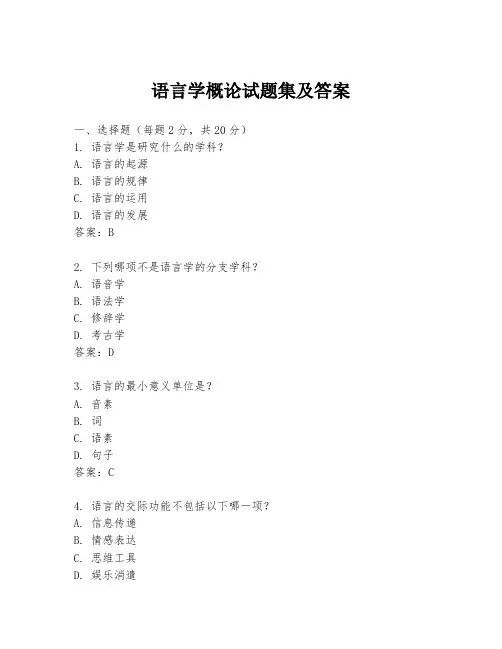
语言学概论试题集及答案一、选择题(每题2分,共20分)1. 语言学是研究什么的学科?A. 语言的起源B. 语言的规律C. 语言的运用D. 语言的发展答案:B2. 下列哪项不是语言学的分支学科?A. 语音学B. 语法学C. 修辞学D. 考古学答案:D3. 语言的最小意义单位是?A. 音素B. 词C. 语素D. 句子答案:C4. 语言的交际功能不包括以下哪一项?A. 信息传递B. 情感表达C. 思维工具D. 娱乐消遣答案:C5. 语言学家索绪尔认为语言的哪两个方面构成了语言系统?A. 语音和语义B. 符号和意义C. 语言和言语D. 语法和词汇答案:C6. 语言的音位学研究的是?A. 语言的语法结构B. 语言的语音系统C. 语言的词汇系统D. 语言的语义系统答案:B7. 语言的语义学研究的是?A. 语言的语音系统B. 语言的语法结构C. 语言的词汇系统D. 语言的意义系统答案:D8. 语言的形态学研究的是?A. 语言的语音系统B. 语言的语法结构C. 语言的词汇系统D. 语言的语义系统答案:B9. 语言的语用学研究的是?A. 语言的语音系统B. 语言的语法结构C. 语言的交际功能D. 语言的语义系统答案:C10. 语言的比较研究属于语言学的哪个分支?A. 社会语言学B. 心理语言学C. 历史语言学D. 计算语言学答案:C二、填空题(每题2分,共20分)1. 语言学研究的对象是______。
答案:人类语言2. 语言的三个基本功能包括______、______和______。
答案:信息传递、情感表达、思维工具3. 语言的最小意义单位是______。
答案:语素4. 语言的______是语言学研究的基础。
答案:规律性5. 语言学家索绪尔认为语言的______和______构成了语言系统。
答案:符号、意义6. 语言的音位学研究的是语言的______。
答案:语音系统7. 语言的语义学研究的是语言的______。
答案:意义系统8. 语言的形态学研究的是语言的______。
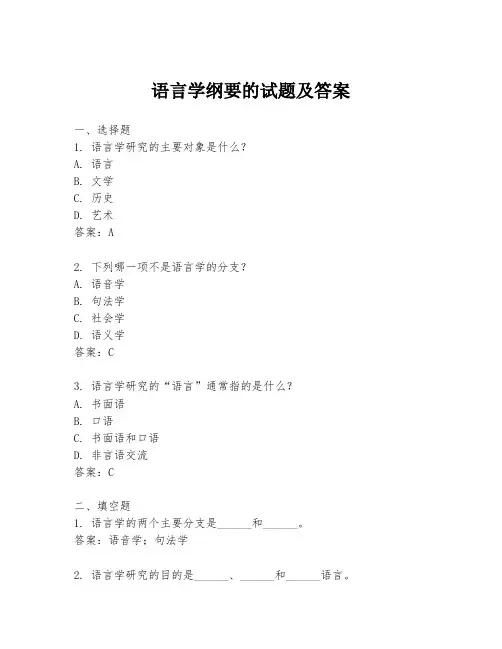
语言学纲要的试题及答案一、选择题1. 语言学研究的主要对象是什么?A. 语言B. 文学C. 历史D. 艺术答案:A2. 下列哪一项不是语言学的分支?A. 语音学B. 句法学C. 社会学D. 语义学答案:C3. 语言学研究的“语言”通常指的是什么?A. 书面语B. 口语C. 书面语和口语D. 非言语交流答案:C二、填空题1. 语言学的两个主要分支是______和______。
答案:语音学;句法学2. 语言学研究的目的是______、______和______语言。
答案:描述;分析;解释3. 语言的三个基本功能是______、______和______。
答案:信息传递;社会互动;思维表达三、简答题1. 简述语言学的发展历程。
答案:语言学的发展历程可以追溯到古希腊时期,但现代语言学的奠基人是索绪尔,他提出了语言符号的任意性和二元对立理论。
20世纪初,结构主义语言学兴起,强调语言的系统性和规则性。
随后,生成语法、社会语言学、心理语言学等新的分支相继出现,推动了语言学的进一步发展。
2. 什么是语言的任意性?答案:语言的任意性是指语言符号的音义关系是任意的,即语言的音和义之间没有必然的联系,这种关系是约定俗成的。
四、论述题1. 论述语言与文化的关系。
答案:语言与文化是相互影响、相互制约的关系。
一方面,语言是文化的重要组成部分,它反映了一个民族的历史、习俗、价值观等文化特征。
另一方面,文化也影响语言的发展和变化,不同的文化背景会导致语言的词汇、语法、表达方式等方面的差异。
此外,语言还可以作为文化传播的媒介,促进不同文化的交流和融合。
2. 描述语言学在现代科技中的应用。
答案:语言学在现代科技中有着广泛的应用,例如在自然语言处理、机器翻译、语音识别等领域。
自然语言处理技术可以分析和理解人类语言,使计算机能够处理和回应自然语言输入。
机器翻译技术利用语言学原理,将一种语言的文本自动翻译成另一种语言。
语音识别技术则使计算机能够识别和理解人类的语音,从而实现语音控制和交互。
论述题目录1.1.举例说明语言符号的聚合关系和组合关系。
1.2。
为什么以客观存在的语言为研究对象的语言学存在着不同的理论、学说和观点?2.1.试述音位和音位变体的关系。
2.2.为什么说一个音位的区别特征是由特定的音位系统决定的?2.3.试述不同的语音在音节结构方面的差别。
2.4.试述音节的音高在声调语言和非声调语言里的作用。
2.5.为什么说重音和轻音通常都是由音强、音高、音长、音质等多方面的因素综合在一起来表现的,而不是仅仅同音强的增加或减弱有关? 2.6.试述声调语言与非声调语言在语调音高形式上的明显差异。
3.1.试述语汇的性质和特点。
3.2.试述语素、音节、字符间的关系。
3.3.汉语与外语的语素类型有哪些异同?3.4.试述构词中派生词的类型。
3.5.试述如何划分汉语的词与词组。
4.1.试述语法规则的性质和特点。
4.2.为什么说语法规律只有一种,而语法规则可以多种多样?4.3.为什么说方言语法实际上是共时语法现象对历时语法现象的反映?4.4.为什么说形态丰富的语言中词法问题重要,而汉语中句法问题更重要?4.5.试述语法单位之间的关系。
4.6.怎样看待语素的语法地位?4.7.试述汉语和英语动词谓语句的下位句型。
5.1.试述语义场的系统性和层次性。
5.2.试述语义场研究的意义。
5.3.举例说明为什么在描写句子的语义结构时,常常要从谓词入手,也就是把谓词看作处于支配地位的核心成分。
5.4.结合实例说明词的派生义产生的现实基础和基本途径。
6.1.语言和文字的关系怎样?6.2.应如何看待“文字发展三阶段论”的观点?6.3.试述“文字的创制”的含义及应注意的问题。
6.4.应如何看待文字的改革?7.1.试述几种不同的语言起源说。
7.2.试述语言发展演变的具体体现。
7.3.试述语言发展演变的原因。
7.4.试述能对语言产生影响的社会因素。
7.5.什么是意译词?请结合实例说明意译词与纯粹音译词及仿译词有什么不同。
语言学概论试题及答案一、单项选择题(每题2分,共20分)1. 语言学研究的核心对象是什么?A. 语言B. 文字C. 文学D. 语音答案:A2. 下列哪一项不是语言学的分支学科?A. 语音学B. 语法学C. 修辞学D. 社会语言学答案:C3. 语言学的发展历程中,结构主义语言学的代表人物是?A. 索绪尔B. 乔姆斯基C. 布隆菲尔德D. 萨丕尔答案:A4. 语言的最小意义单位是什么?A. 音素B. 词汇C. 语素D. 句子答案:C5. 以下哪个选项是语言的任意性特点?A. 语言的音义结合是任意的B. 语言的音义结合是固定的C. 语言的音义结合是可预测的D. 语言的音义结合是无规律的答案:A二、填空题(每题2分,共20分)1. 语言学的研究方法主要包括________和________。
答案:描述性方法;比较方法2. 语言的两种基本功能是__________和__________。
答案:表达思想;交流信息3. 语言的变异性主要表现在__________、__________和__________。
答案:地域、社会和时间4. 语音学中,元音和辅音的区别在于__________。
答案:声带振动与否5. 语言的系统性表现在__________和__________。
答案:结构的层次性;功能的多样性三、简答题(每题10分,共30分)1. 简述语言的交际功能。
答案:语言的交际功能是指语言作为人类社会交流思想、情感和信息的工具,它使得人们能够相互理解和沟通。
2. 描述语言的创造性特点。
答案:语言的创造性特点是指人们能够使用有限的语言资源,通过不同的组合和结构,创造出无限多的新句子和表达方式。
3. 举例说明语言的规范性。
答案:语言的规范性是指在一定的社会和文化背景下,人们对语言的使用有一定的规则和标准。
例如,语法规则、词汇用法和发音标准等。
四、论述题(每题15分,共30分)1. 论述语言和文化的关系。
答案:语言和文化是相互影响、相互渗透的。
语言学考试试题及答案一、选择题(每题2分,共20分)1. 语言学是研究语言的科学,它包括以下哪些分支学科?A. 语音学B. 语法学C. 语义学D. 所有选项答案:D2. 下列哪个术语不是语言学的分支?A. 社会语言学B. 心理语言学C. 神经语言学D. 化学语言学答案:D3. 语言的最小意义单位是什么?A. 音素B. 词素C. 词D. 句子答案:B4. 以下哪个选项是语言的语音属性?A. 音高B. 音长C. 音色D. 所有选项答案:D5. 语言的语法规则可以是:A. 显性的B. 隐性的C. 两者都是D. 两者都不是答案:C6. 以下哪种语言现象不属于语言变异?A. 方言B. 社会方言C. 语言接触D. 语言消亡答案:D7. 语言的演变通常被认为是:A. 随机的B. 有目的的C. 无意识的D. 有意识的答案:C8. 语言接触可能导致:A. 语言融合B. 语言分离C. 语言借用D. 所有选项答案:D9. 语言的语用学研究的是:A. 语言的语境B. 语言的功能C. 语言的意义D. 所有选项答案:D10. 以下哪个术语不属于语义学研究的范围?A. 语义场B. 语义角色C. 语义关系D. 音位学答案:D二、填空题(每题2分,共20分)1. 语言的______属性包括音高、音长和音色。
答案:语音2. 语言的______属性包括语法、词汇和语义。
答案:结构3. 语言的______属性涉及语言的社会和文化方面。
答案:社会4. 语言学中的______理论认为语言是一系列规则的集合。
答案:形式主义5. 语言的______是语言学研究的基础单位。
答案:句子6. 语言的______是指语言在不同社会群体中的变体。
答案:变异7. 语言的______是指语言在不同地理区域的变体。
答案:方言8. 语言的______是指语言在不同时间的演变。
答案:历史9. 语言的______是指语言在不同语境中的使用。
答案:语用10. 语言的______是指语言的抽象意义。
现代语言学试题及答案一、选择题(每题2分,共20分)1. 现代语言学研究的核心是什么?A. 语言的起源B. 语言的演变C. 语言的规则D. 语言的功能答案:C2. 以下哪项不是语言学的分支?A. 语音学B. 语法学C. 心理学D. 语义学答案:C3. 语言学中的“phoneme”指的是什么?A. 音位B. 音素C. 音节D. 音标答案:A4. 下列哪个选项是“语言接触”的结果?A. 语言的消亡B. 语言的产生C. 语言的融合D. 语言的孤立答案:C5. 以下哪种语言现象不属于词汇变化?A. 合成B. 派生C. 借用D. 语音变化答案:D6. 语言学中的“transformational grammar”是什么?A. 转换语法B. 句法分析C. 语义分析D. 语音学答案:A7. 以下哪个术语与语言的“社会功能”无关?A. 语言的规范B. 语言的变异C. 语言的习得D. 语言的交际答案:C8. “语言的普遍语法”是哪位语言学家提出的?A. 费尔迪南·德·索绪尔B. 诺姆·乔姆斯基C. 爱德华·萨丕尔D. 威廉·冯·洪堡特答案:B9. 以下哪种语言现象不属于语用学研究范畴?A. 言语行为B. 语境分析C. 语音变化D. 隐喻答案:C10. “语言的相对性原则”是哪种语言理论的核心?A. 结构主义B. 形式主义C. 功能主义D. 心理语言学答案:A二、填空题(每题2分,共20分)1. 语言学的创始人是________。
答案:费尔迪南·德·索绪尔2. 语言学中,________是指语言的最小意义单位。
答案:语素3. 语言的________是指语言在特定社会环境中的使用。
答案:语境4. 语言学中的________是指语言的音韵结构。
答案:音韵学5. 语言的________是指语言的词汇和语法结构。
答案:形式6. 语言学中的________是指语言的规则系统。
1、How is Saussure’s distinction between langue and parole similar to Chomsky’s distinction between competence and performance?Saussure’s distinction and Chomsky’s are very similar in that they both think that language can be divided into two levels, one level is abstract (e.g. langue; competence) and the other concrete (e.g. parole; performance). And they also think that what linguists should deal with is the abstract level which can reveal the real nature of language. At the same time, they differ at least in that Saussure took a sociological view of language and his notion of language is a matter of social conventions, and Chomsky looks at language from a psychological point of view and to him competence is a property of the mind of each individual.2、What is a phone? How is it different from a phoneme? How are allophones related to a phoneme?A phone is a phonetic unit or segment. The speech sounds we hear and produce during communication are all phones.A phoneme is not any particular sound, but rather it is represented or realized by a certain phone in a certain phonetic context. The different phones which can represent a phoneme in different phonetic environments are called the allophones of that phoneme. For example, the phoneme /p/ in English can be realized as [p] and [ph], which are allophones of the phoneme /p/.3、What are the major views concerning the study of meaning?(1) The naming theory proposed by the ancient Greek scholar Plato. According to this theory, the linguistic forms or symbols, in other words, the words used in a language are simply labels of the objects they stand for. So words are just names or labels for things.(2) The conceptualist view has been held by some philosophers and linguists from ancient times. This view holds that there is no direct link between a linguistic form and what it refers to (i. e., between language and the real world); rather, in the interpretation of meaning they are linked through the mediation of concepts in the mind.(3) The contextualist view held that meaning should be studied in terms of situation, use, context ––elements closely linked with language behaviour. The representative of this approach was J.R. Firth, famous British linguist.(4) Behaviorists attempted to define the meaning of a language form as the “situation in which the speaker utters it and the response it calls forth in the hearer.”This theory, somewhat close to contextualism, is linked with psychological interest.4、What are the five types of illocutionary speech acts Searle has specified? What is the illocutionary point of each type?(1) representatives: stating or describing, saying what the speaker believes to be true(2) directives: trying to get the hearer to do something(3) commissives: committing the speaker himself to some future course of action(4) expressives: expressing feelings or attitude towards an existing(5) declarations: bringing about immediate changes by saying somethingThe illocutionary point of the representatives is to commit the speaker to something's being the case, to the truth of what has been said, in other words, when performing an illocutionary act of representative, the speaker is making a statement or giving a description which he himself believes to be true. Stating, believing, sweating, hypothesizing are among the most typical of the representatives.Directives ate attempts by the speaker to get the hearer to do some- thing. Inviting, suggesting, requesting, advising, wanting, threatening and ordering are all specific instances of this class.Commissives are those illocutionary acts whose point is to commit the speaker to some future course of action, i.e. when speaking the speaker puts himself under a certain obligation. Promising, undertaking, vowing are the most typical ones.The illocutionary point of expressives is to express the psychological state specified in the utterance. The speaker is expressing his feelings or attitudes towards an existing state of affairs, e.g. apologizing, thanking, congratulating.The last class “declarations”has the characteristic that the successful performance of an act of this type brings about the correspondence between what is said and reality.5、How do bilingualism and diglossia differ, and what do they have in common?The language acquisition theories mentioned in this chapter have different emphasis on different aspects. Behaviorists view sounds reasonable in explaining the routine aspects, the innatist accounts most plausible in explaining children's acquiring complex system, and the interactive description convincing in understanding how children learn and use the language appropriately from their environment. In my opinion, behaviorists view is more reasonable and convincingbecause language acquisition is a process of enforcing and reinforcing. Only through this process can a person learn a language well. Bilingualism refers to the situation that in some speech communities, two languages are used side by side with each having a different role to play; and language switching occurs when the situation changes. But instead of two different languages, in a diglossic situation, two varieties of a language exit side by side through out the community, with each having a definite role to play.The two languages of bilingualism and the two varieties of diglossic each has different role to play as situation changes.6、Based on your own learning experiences, please illustrate how important it is to learn its culture when learning a foreign language?Based on my own learning experiences, I find it is very important to learn its culture when learning a foreign language, A typical example of these is that when greeting acquaintances, we tend to say "Have you eaten?", which will cause misunderstanding to a foreigner.7、Among the language acquisition theories mentioned in this chapter, which one do you think is more reasonable and convincing? Explain why.The language acquisition theories mentioned in this chapter have different emphasis on different aspects. Behaviorists view sounds reasonable in explaining the routine aspects, the innatist accounts most plausible in explaining children's acquiring complex system, and the interactive description convincing in understanding how children learn and use the language appropriately from their environment. In my opinion, behaviorists view is more reasonable and convincing because language acquisition is a process of enforcing and reinforcing. Only through this process can a person learn a language well.。
语言学考研试题及答案一、选择题(每题2分,共20分)1. 语言学的主要研究对象是什么?A. 语言的起源B. 语言的语音、语法、词汇、语义C. 语言的演变D. 语言的交际功能答案:B2. 下列哪一项不是语言的属性?A. 创造性B. 任意性C. 规律性D. 稳定性答案:D3. 语音学研究的内容不包括以下哪一项?A. 发音器官B. 音位C. 语调D. 词汇答案:D4. 以下哪个概念不属于句法学?A. 短语结构B. 转换生成C. 语义角色D. 词汇语义答案:D5. 语义学研究的核心问题是什么?A. 语言的起源B. 语言的演变C. 语言的意义D. 语言的交际功能答案:C6. 社会语言学主要研究的是以下哪方面的内容?A. 语言的语音、语法、词汇、语义B. 语言与社会的关系C. 语言的演变D. 语言的交际功能答案:B7. 心理语言学研究的是以下哪方面的内容?A. 语言的起源B. 语言与心理的关系C. 语言的演变D. 语言的交际功能答案:B8. 计算语言学主要应用在哪个领域?A. 语言的起源B. 语言的演变C. 语言的交际功能D. 语言信息处理答案:D9. 语言接触导致的最常见现象是什么?A. 语言混合B. 语言分化C. 语言融合D. 语言消亡答案:C10. 以下哪项是方言学研究的内容?A. 语言的起源B. 语言的语音、语法、词汇、语义C. 语言的演变D. 语言的地域差异答案:D二、填空题(每题2分,共20分)1. 语言学的分支学科包括语音学、______学、句法学、语义学等。
答案:语法2. 语言的最小意义单位是______。
答案:语素3. 语言的音位和音素之间的区别在于______。
答案:音位是社会约定的,音素是物理的4. 语言的任意性原则是由______提出的。
答案:索绪尔5. 语言的转换生成理论是由______提出的。
答案:乔姆斯基6. 语言的交际功能包括______、表达和理解。
答案:编码7. 社会语言学研究语言与______的关系。
1、How is Saussure’s distinction between langue and parole similar to Chomsky’s distinction between competence and performance?Saussure’s distinction and Chomsky’s are very similar in that they both think that language can be divided into two levels, one level is abstract (e.g. langue; competence) and the other concrete (e.g. parole; performance). And they also think that what linguists should deal with is the abstract level which can reveal the real nature of language. At the same time, they differ at least in that Saussure took a sociological view of language and his notion of language is a matter of social conventions, and Chomsky looks at language from a psychological point of view and to him competence is a property of the mind of each individual.2、What is a phone? How is it different from a phoneme? How are allophones related to a phoneme?A phone is a phonetic unit or segment. The speech sounds we hear and produce during communication are all phones.A phoneme is not any particular sound, but rather it is represented or realized by a certain phone in a certain phonetic context. The different phones which can represent a phoneme in different phonetic environments are called the allophones of that phoneme. For example, the phoneme /p/ in English can be realized as [p] and [ph], which are allophones of the phoneme /p/.3、What are the major views concerning the study of meaning?(1) The naming theory proposed by the ancient Greek scholar Plato. According to this theory, the linguistic forms or symbols, in other words, the words used in a language are simply labels of the objects they stand for. So words are just names or labels for things.(2) The conceptualist view has been held by some philosophers and linguists from ancient times. This view holds that there is no direct link between a linguistic form and what it refers to (i. e., between language and the real world); rather, in the interpretation of meaning they are linked through the mediation of concepts in the mind.(3) The contextualist view held that meaning should be studied in terms of situation, use, context ––elements closely linked with language behaviour. The representative of this approach was J.R. Firth, famous British linguist.(4) Behaviorists attempted to define the meaning of a language form as the “situation in which the speaker utters it and the response it calls forth in the hearer.”This theory, somewhat close to contextualism, is linked with psychological interest.4、What are the five types of illocutionary speech acts Searle has specified? What is the illocutionary point of each type?(1) representatives: stating or describing, saying what the speaker believes to be true(2) directives: trying to get the hearer to do something(3) commissives: committing the speaker himself to some future course of action(4) expressives: expressing feelings or attitude towards an existing(5) declarations: bringing about immediate changes by saying somethingThe illocutionary point of the representatives is to commit the speaker to something's being the case, to the truth of what has been said, in other words, when performing an illocutionary act of representative, the speaker is making a statement or giving a description which he himself believes to be true. Stating, believing, sweating, hypothesizing are among the most typical of the representatives.Directives ate attempts by the speaker to get the hearer to do some- thing. Inviting, suggesting, requesting, advising, wanting, threatening and ordering are all specific instances of this class.Commissives are those illocutionary acts whose point is to commit the speaker to some future course of action, i.e. when speaking the speaker puts himself under a certain obligation. Promising, undertaking, vowing are the most typical ones.The illocutionary point of expressives is to express the psychological state specified in the utterance. The speaker is expressing his feelings or attitudes towards an existing state of affairs, e.g. apologizing, thanking, congratulating.The last class “declarations”has the characteristic that the successful performance of an act of this type brings about the correspondence between what is said and reality.5、How do bilingualism and diglossia differ, and what do they have in common?The language acquisition theories mentioned in this chapter have different emphasis on different aspects. Behaviorists view sounds reasonable in explaining the routine aspects, the innatist accounts most plausible in explaining children's acquiring complex system, and the interactive description convincing in understanding how children learn and use the language appropriately from their environment. In my opinion, behaviorists view is more reasonable and convincingbecause language acquisition is a process of enforcing and reinforcing. Only through this process can a person learn a language well. Bilingualism refers to the situation that in some speech communities, two languages are used side by side with each having a different role to play; and language switching occurs when the situation changes. But instead of two different languages, in a diglossic situation, two varieties of a language exit side by side through out the community, with each having a definite role to play.The two languages of bilingualism and the two varieties of diglossic each has different role to play as situation changes.6、Based on your own learning experiences, please illustrate how important it is to learn its culture when learning a foreign language?Based on my own learning experiences, I find it is very important to learn its culture when learning a foreign language, A typical example of these is that when greeting acquaintances, we tend to say "Have you eaten?", which will cause misunderstanding to a foreigner.7、Among the language acquisition theories mentioned in this chapter, which one do you think is more reasonable and convincing? Explain why.The language acquisition theories mentioned in this chapter have different emphasis on different aspects. Behaviorists view sounds reasonable in explaining the routine aspects, the innatist accounts most plausible in explaining children's acquiring complex system, and the interactive description convincing in understanding how children learn and use the language appropriately from their environment. In my opinion, behaviorists view is more reasonable and convincing because language acquisition is a process of enforcing and reinforcing. Only through this process can a person learn a language well.。